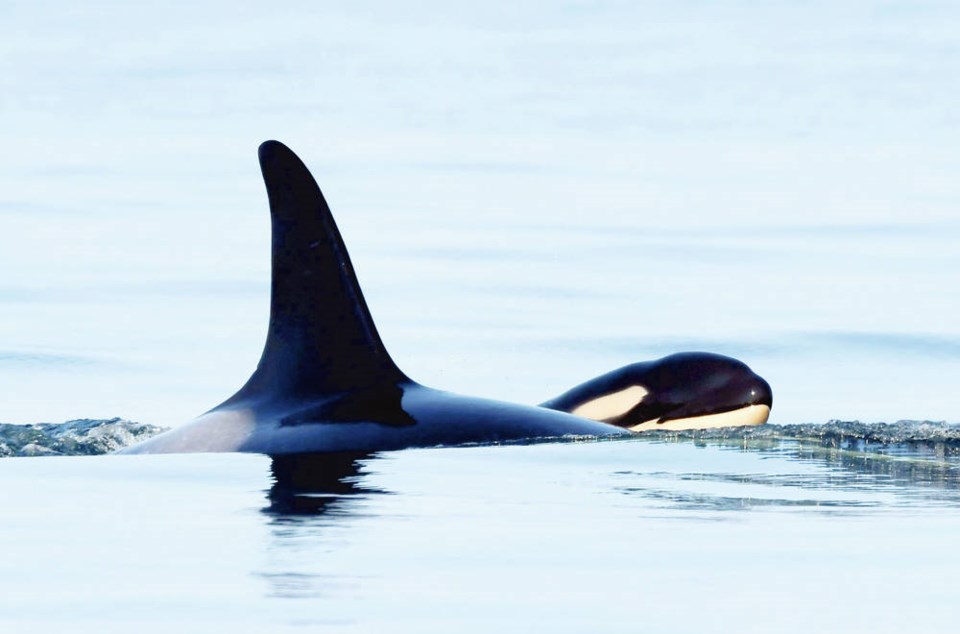A baby girl. The mother orca looked at her daughter and, thanks to her sense of echolocation, knew her baby wasn’t healthy.
She knew the breathing was too shallow, the heartbeat too weak. After swimming off Clover Point, near Victoria, for less than an hour, the beautiful little orca gasped her last and the mother, known to humans as Tahlequah, dove to catch the body. Like so many mother orcas before her, Tahlequah set out to show her dead calf to her family, J pod.
Perhaps Tahlequah planned to show the body to the other pods as well, at a gathering of the clans humans call a superpod. Instead, she showed her daughter to the world, in what became known as a tour of grief.
The 20-year-old Southern Resident carried and cradled her daughter’s body for 17 days as the world’s media shared the story with a mix of fascination, horror and guilt. Whether Tahlequah was talking to us or not, her message was clear: we did this.
Some people claimed other orcas helped her carry her daughter, or they delivered food so the grieving orca could eat. We don’t know.
But what we do know is that she didn’t drop her calf, and she didn’t lose weight. So the idea that Tahlequah had help from her family seems more plausible than the possibility that she didn’t sleep or eat for over two weeks, but didn’t lose weight or sink from exhaustion.
Thanks to Tahlequah’s epic tour, the American and Canadian governments worked together with the Lummi Nation and a mix of organizations with varying views on captivity to try to rescue and rehabilitate one of Tahlequah’s podmates, Scarlet.
The spunky three-year-old orca was starving, and because the world was watching, attempts were made to diagnose and treat her. It was a classic case of too little, too late. Warnings were sounded— and ignored—prior to Tahlequah stealing the media spotlight. But the idea of cross- border cooperation and marine park veterinarians working with anti-captivity organizations raised the possibility that humans could put their own politics aside to fight for the orcas.
Tahlequah’s tour set the stage for a new approach to saving the endangered Southern Resident orca population. The following year Washington Gov. Jay Inslee proposed putting more than $1 billion into orca recovery, and the Canadian government declared they’d spend at least $200 million to help save the Southern Residents.
In 2019, the month of June, which had long been known as Orca Awareness Month in Canada and the United States, was renamed Orca Action Month.
Tahlequah accomplished what generations of human orca advocates couldn’t. She shamed politicians into action. It remains to be seen whether her message was received in time.
The above is an excerpt from Spirits of the Coast: Orcas in Science, Art and History, published by the Royal B.C. Museum.
An update from Leiren-Young:
On Friday, Sept. 4, Tahlequah was seen with a new baby, who entered the scientific records as J57.
As I write this, there’s no word on whether the latest member of J Pod is a boy or a girl, but Ken Balcomb, founder of the Center for Whale Research said the baby looks “very robust and lively.”
All the Southern Residents celebrated the new arrival by gathering in a superpod — the first seen in the Salish Sea this year. Orcas in both K Pod and L Pod are also pregnant. It’s up to us to make sure the new southern residents have enough chinook to eat and cleaner, quieter oceans. Perhaps, they’ll name one of these new orcas, “Hope.”
Leiren-Young’s book, Orcas Everywhere — The Mystery and History of Killer Whales, has just been named to the shortlist for the City of Victoria’s Children’s Book Award.



